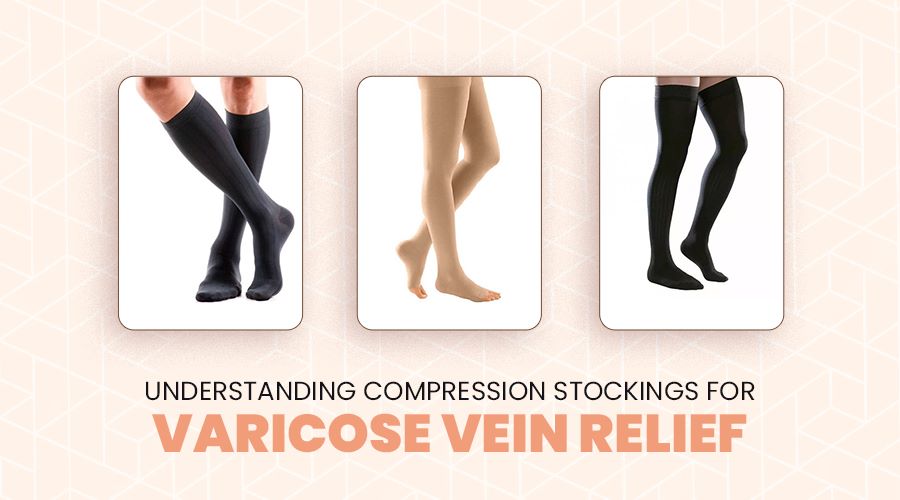Understanding Compression Stockings for Varicose Vein Relief




Living with varicose veins in the legs can be a daily struggle, with painful symptoms making each step a challenge. Unfortunately, immediate leg vein treatment may not always be feasible due to various reasons such as location, pregnancy, or availability. In such situations, could compression stockings provide some relief from these distressing symptoms?
To comprehend the potential benefits of applying compression to legs afflicted with venous insufficiency, it's crucial to understand what goes on inside normal and abnormal leg veins. Veins play a vital role in returning blood to the heart through one-way valves lining their interiors. However, when these valves malfunction, blood flows backward, causing it to pool within the veins. This pooling leads to the swelling of veins, making them appear as protruding, twisted, and bluish vessels on the skin's surface.
As a consequence, uncomfortable symptoms often manifest themselves. These may include throbbing sensations, a dull ache in the legs, a feeling of heaviness, restless legs at night, swelling, and general pain. Varicose veins need not continue dictating your daily experience, for relief might be found in the form of a compression stocking.
Let's delve deeper into the potential of these medical compression stockings to alleviate discomfort and enhance your well-being, empowering you to reclaim your stride with confidence and ease.
Compression Stockings - Types
Stockings for varicose veins come in three primary types, each serving specific purposes for various conditions: medical or graduated compression stockings, anti-embolism stockings, and non-medical support stockings.
● Medical or graduated compression stockings:
These are specifically crafted to address chronic venous disease and swelling. They exert the highest level of compression at the ankle and gradually decrease as they ascend towards the top of the stocking. These stockings are designed for ambulatory patients, focusing on individuals who can walk rather than those confined to bed.
● Anti-embolism stockings:
On the other hand, anti-embolism stockings also feature graduated compression. However, their primary objective is to minimize the risk of deep vein thrombosis (DVT) in bedridden patients. These stockings are not intended for individuals who are capable of walking.
● Non-medical support stockings:
Lastly, we have non-medical support stockings, which provide a consistent level of compression throughout the stocking, rather than a progressive compression gradient. These stockings are commonly used to alleviate leg discomfort and are usually sold for the purpose of preventing aching legs. It's important to note that the level of compression in non-medical support stockings is generally lower compared to medical or anti-embolism compression stockings.
Understanding the distinctions between these different types of compression stockings allows individuals to select the most suitable option based on their specific needs and conditions. Whether you require targeted treatment for chronic venous disease, DVT prevention for bedridden patients, or general support for leg discomfort, compression stockings offer a versatile range of options to cater to varying requirements.
How Compression Garments Help in Varicose Veins?
The application of compression therapy to legs affected by varicose veins brings forth several beneficial effects:
1. Increased Speed of Blood Flow: Compression stockings exert pressure on the major veins in the legs, effectively reducing their diameter. This compression leads to an accelerated velocity of blood flow, facilitating efficient circulation.
2. Reversal of Venous Hypertension: Venous insufficiency causes blood to pool within the veins, resulting in the bulging appearance of veins on the skin's surface and creating venous hypertension. Compression stockings provide support to the vein walls, preventing them from overstretching and reversing the effects of hypertension. It's important to note that this reversal is temporary, as the hypertension returns once the stockings are removed.
3. Overcoming Gravity Effects: Incompetent or leaky veins already face the challenge of working against gravity to push blood towards the heart. Graduated compression, applied from the feet upwards, helps alleviate the drag of gravity on blood flow, assisting in its upward movement.
4. Support for the Calf-Muscle Pump: The calf-muscle pump refers to a group of muscles in the legs that aid in circulation by contracting and squeezing blood along the veins towards the heart. Compression garments provide amplification and support to this natural pumping mechanism, further enhancing circulation.
5. Improved Lymphatic Drainage and Reduction of Swelling: Compression therapy assists in promoting lymphatic drainage, helping to alleviate chronic fluid buildup and reduce swelling in the limbs.
Research has demonstrated that wearing compression stockings for varicose veins lead to improved oxygenation of the legs and a reduction in the number of inflammatory cells in patients with active leg ulcers. This highlights the effectiveness of compression therapy in enhancing healing and alleviating symptoms.
Patients with varicose veins, regardless of the severity, often report significant improvements in symptoms such as pain and swelling. Compression garments offer a multifaceted approach to managing varicose veins, providing relief and enhancing overall well-being for those affected by this condition.
Shop for the best quality compression stockings in the UAE from Sehaaonline.











